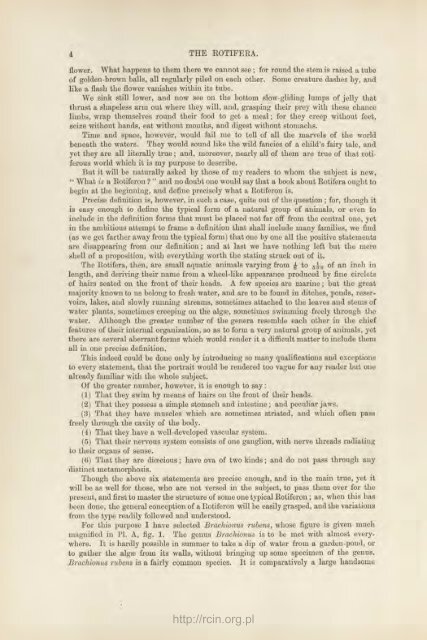Create successful ePaper yourself
Turn your PDF publications into a flip-book with our unique Google optimized e-Paper software.
flower. What happens to <strong>the</strong>m <strong>the</strong>re we cannot see ; for round <strong>the</strong> stem is raised a tube<br />
of golden-brown balls, all regularly piled on each o<strong>the</strong>r. Some creature dashes by, and<br />
like a flash <strong>the</strong> flower vanishes within its tube.<br />
We sink still lower, and now see on <strong>the</strong> bottom slow-gliding lumps of jelly that<br />
thrust a shapeless arm out where <strong>the</strong>y will, and, grasping <strong>the</strong>ir prey with <strong>the</strong>se chance<br />
limbs, wrap <strong>the</strong>mselves round <strong>the</strong>ir food to get a meal; for <strong>the</strong>y creep without feet,<br />
seize without hands, eat without mouths, and digest without stomachs.<br />
Time and space, however, would fail me to tell of all <strong>the</strong> marvels of <strong>the</strong> world<br />
beneath <strong>the</strong> waters. They would sound like <strong>the</strong> wild fancies of a child's fairy tale, and<br />
yet <strong>the</strong>y are all literally true; and, moreover, nearly all of <strong>the</strong>m are true of that rotiferous<br />
world which it is my purpose to describe.<br />
But it will be naturally asked by those of my readers to whom <strong>the</strong> subject is new,<br />
" What is a Rotiferon ? " and no doubt one would say that a book about Rotifera ought to<br />
begin at <strong>the</strong> beginning, and define precisely what a Rotiferon is.<br />
Precise definition is, however, in such a case, quite out of <strong>the</strong> question ; for, though it<br />
is easy enough to define <strong>the</strong> typical form of a natural group of animals, or even to<br />
include in <strong>the</strong> definition forms that must be placed not far off from <strong>the</strong> central one, yet<br />
in <strong>the</strong> ambitious attempt to frame a definition that shall include many families, we find<br />
(as we get far<strong>the</strong>r away from <strong>the</strong> typical form) that one by one all <strong>the</strong> positive statements<br />
are disappearing from our definition ; and at last we have nothing left but <strong>the</strong> mere<br />
shell of a proposition, with everything worth <strong>the</strong> stating struck out of it.<br />
The Rotifera, <strong>the</strong>n, are small aquatic animals varying from £ to ^^ of an inch in<br />
length, and deriving <strong>the</strong>ir name from a wheel-like appearance produced by fine circlets<br />
of hairs seated on <strong>the</strong> front of <strong>the</strong>ir heads. A few species are marine; but <strong>the</strong> great<br />
majority known to us belong to fresh water, and are to be found in ditches, ponds, reservoirs,<br />
lakes, and slowly running streams, sometimes attached to <strong>the</strong> leaves and stems of<br />
water plants, sometimes creeping on <strong>the</strong> algae, sometimes swimming freely through <strong>the</strong><br />
water. Although <strong>the</strong> greater number of <strong>the</strong> genera resemble each o<strong>the</strong>r in <strong>the</strong> chief<br />
features of <strong>the</strong>ir internal organization, so as to form a very natural group of animals, yet<br />
<strong>the</strong>re are several aberrant forms which would render it a difficult matter to include <strong>the</strong>m<br />
all in one precise definition.<br />
This indeed could be done only by introducing so many qualifications and exceptions<br />
to every statement, that <strong>the</strong> portrait would be rendered too vague for any reader but one<br />
already familiar with <strong>the</strong> whole subject.<br />
Of <strong>the</strong> greater number, however, it is enough to say:<br />
(1) That <strong>the</strong>y swim by means of hairs on <strong>the</strong> front of <strong>the</strong>ir heads.<br />
(2) That <strong>the</strong>y possess a simple stomach and intestine ; and peculiar jaws.<br />
(8) That <strong>the</strong>y have muscles which are sometimes striated, and which often pass<br />
freely through <strong>the</strong> cavity of <strong>the</strong> body.<br />
(4) That <strong>the</strong>y have a well-developed vascular system.<br />
(5) That <strong>the</strong>ir nervous system consists of one ganglion, with nerve threads radiating<br />
to <strong>the</strong>ir organs of sense.<br />
(6) That <strong>the</strong>y are dioecious; have ova of two kinds; and do not pass through any<br />
distinct metamorphosis.<br />
Though <strong>the</strong> above six statements are precise enough, and in <strong>the</strong> main true, yet it<br />
will be as well for those, who are not versed in <strong>the</strong> subject, to pass <strong>the</strong>m over for <strong>the</strong><br />
present, and first to master <strong>the</strong> structure of some one typical Rotiferon ; as, when this has<br />
been done, <strong>the</strong> general conception of a Rotiferon will be easily grasped, and <strong>the</strong> variations<br />
from <strong>the</strong> type readily followed and understood.<br />
For this purpose I have selected Brachionus rubens, whose figure is given much<br />
magnified in I'l. A, fig. 1. The genus Brachionus is to be met with almost everywhere.<br />
It is hardly possible in summer to take a dip of water from a garden-pond, or<br />
to ga<strong>the</strong>r <strong>the</strong> algae from its walls, without bringing up some specimen of <strong>the</strong> genus.<br />
Brachionus rubens is a fairly common species. It is comparatively a large handsome<br />
http://rcin.org.pl
















